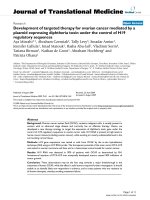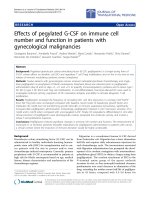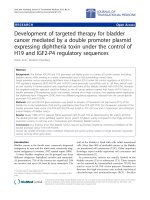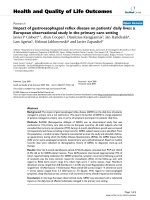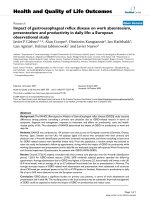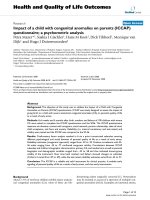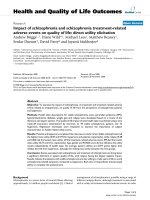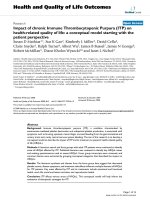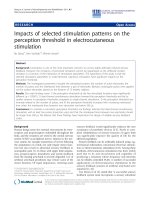báo cáo hóa học: "Impact of gastroesophageal reflux disease on patients'''' daily lives: a European observational study in the primary care setting" doc
Bạn đang xem bản rút gọn của tài liệu. Xem và tải ngay bản đầy đủ của tài liệu tại đây (305.96 KB, 8 trang )
BioMed Central
Page 1 of 8
(page number not for citation purposes)
Health and Quality of Life Outcomes
Open Access
Research
Impact of gastroesophageal reflux disease on patients' daily lives: a
European observational study in the primary care setting
Javier P Gisbert*
1
, Alun Cooper
2
, Dimitrios Karagiannis
3
, Jan Hatlebakk
4
,
Lars Agréus
5
, Helmut Jablonowski
6
and Javier Zapardiel
7
Address:
1
Department of Gastroenterology, Hospital Universitario de la Princesa, Madrid, Spain, and Centro de Investigación Biomédica en Red
de Enfermedades Hepáticas y Digestivas (CIBEREHD), Spain,
2
Bridge Medical Centre, Crawley, West Sussex, UK,
3
Department of
Gastroenterology, Athens Medical Center, Athens, Greece,
4
Institute of Medicine, Haukeland University Hospital, Bergen, Norway,
5
Center for
Family and Community Medicine, Karolinska Institutet, Huddinge/Stockholm, Sweden,
6
Klinikum Salzgitter GmbH, Salzgitter, Germany and
7
AstraZeneca, Madrid, Spain
Email: Javier P Gisbert* - ; Alun Cooper - ; Dimitrios Karagiannis - ;
Jan Hatlebakk - ; Lars Agréus - ; Helmut Jablonowski - ;
Javier Zapardiel -
* Corresponding author
Abstract
Background: The impact of gastroesophageal reflux disease (GERD) on the daily lives of patients
managed in primary care is not well known. We report the burden of GERD in a large population
of patients managed in primary care, in terms of symptoms and impact on patients' daily lives.
Methods: RANGE (Retrospective ANalysis of GERD) was an observational study that was
conducted at 134 primary care sites across six European countries. All adult subjects who had
consulted their primary care physician (PCP) during a 4-month identification period were screened
retrospectively and those consulting at least once for GERD-related reasons were identified. From
this population, a random sample of patients was selected to enter the study and attended a follow-
up appointment, during which the Reflux Disease Questionnaire (RDQ), the GERD Impact Scale
(GIS) and an extra-esophageal symptoms questionnaire were self-administered. Based on medical
records, data were collected on demographics, history of GERD, its diagnostic work-up and
therapy.
Results: Over the 4-month identification period, 373,610 subjects consulted their PCP and 12,815
(3.4%) did so for GERD-related reasons. From 2678 patients interviewed (approximately 75% of
whom reported taking medication for GERD symptoms), symptom recurrence following a period
of remission was the most common reason for consultation (35%). At the follow-up visit, with
regard to RDQ items (score range 0–5, where high score = worse status), mean Heartburn
dimension scores ranged from 0.8 (Sweden) to 1.2 (UK) and mean Regurgitation dimension scores
ranged from 1.0 (Norway) to 1.4 (Germany). Mean overall GIS scores (range 1–4, where low score
= worse status) ranged from 3.3 (Germany) to 3.5 (Spain). With regard to extra-esophageal
symptoms, sleep disturbance was common in all countries in terms of both frequency and intensity.
Conclusion: In this large European observational study, GERD was associated with a substantial
impact on the daily lives of affected individuals managed in the primary care setting.
Published: 2 July 2009
Health and Quality of Life Outcomes 2009, 7:60 doi:10.1186/1477-7525-7-60
Received: 1 April 2009
Accepted: 2 July 2009
This article is available from: />© 2009 Gisbert et al; licensee BioMed Central Ltd.
This is an Open Access article distributed under the terms of the Creative Commons Attribution License ( />),
which permits unrestricted use, distribution, and reproduction in any medium, provided the original work is properly cited.
Health and Quality of Life Outcomes 2009, 7:60 />Page 2 of 8
(page number not for citation purposes)
Background
Gastroesophageal reflux disease (GERD) is a chronic con-
dition in which reflux of stomach contents causes trouble-
some symptoms and/or complications [1]. The disease
can present in terms of a range of esophageal and extra-
esophageal syndromes, but its cardinal symptoms are
heartburn and regurgitation [1]. It is increasingly recog-
nised that such symptoms can be severely detrimental to
health-related quality of life (HRQOL), disrupting
patients' daily lives in terms of physical, social and emo-
tional well-being [2,3]. Indeed, the negative effect of
GERD on HRQOL is becoming better defined as research-
ers increasingly make use of patient-reported outcome
(PRO) instruments to investigate the impact of GERD
symptoms in large populations [4]. The German ProG-
ERD study, for example, determined that patients with
symptoms of GERD had substantially impaired HRQOL
in terms of both physical and psychosocial aspects of well-
being compared with the general population, and felt
restricted as a result of food and drink problems, dis-
turbed sleep, and impaired vitality and emotional well-
being [5]. Studies conducted in the Swedish general pop-
ulation assessing the impact of the severity and frequency
of GERD symptoms on HRQOL have found that even
symptoms rated as mild are associated with a clinically
meaningful reduction in well-being [6], and that weekly
symptoms are likely to have a clinically significant adverse
impact on most aspects of patients' daily lives [7]. Conse-
quently, the impact of symptoms on patients' daily lives is
one of the most common reasons for consultation for
GERD [8], which accounts for a significant workload
among primary care physicians (PCPs) [9]. However, the
impact of symptoms of GERD among patients who are
managed and treated in primary care has not been well
studied.
As part of the RANGE (Retrospective ANalysis of GERD)
study, which aimed to document the symptom profile,
diagnosis and management of GERD patients in several
European countries, we evaluated the burden of GERD
using a selection of PRO instruments, the results of which
are reported in this paper.
Methods
Study design and patients
RANGE was a multicentre, multinational, observational
study (AstraZeneca study code: D9612L00114) con-
ducted as a series of parallel, locally managed studies at
134 primary care sites across six European countries (Ger-
many, Greece, Norway, Spain, Sweden and the UK). The
study was conducted in accordance with the ethical prin-
ciples described in the Declaration of Helsinki, and was
approved by local ethics committees in each country.
The full design of the RANGE study is illustrated in Figure
1. During a 4-month identification period, all subjects
(aged ≥ 18 years) who consulted with their PCP for any
reason were identified ('total population'). Based on a ret-
rospective medical record review of the total population,
patients consulting at least once for a GERD-related rea-
son (with or without treatment, and regardless of whether
GERD was the main reason for the visit) were identified
('study population'). Subjects were considered to have
consulted their PCP for a GERD-related reason if they met
at least one of the following criteria: they reported trou-
blesome heartburn and/or regurgitation; GERD had been
diagnosed by endoscopy (presence of esophagitis),
esophageal pH monitoring (pathological esophageal pH)
or by the presence of symptoms only (heartburn and/or
regurgitation); GERD complications were recorded
(including haemorrhage, stricture or Barrett's metaplasia);
or they were prescribed acid-suppressive medication (pro-
ton pump inhibitors [PPIs] or H
2
receptor antagonists)
and/or antacids for GERD. Subjects were included in the
study population irrespective of the number of times they
had attended the primary care clinic during the identifica-
tion period. Patients participating in the study were
required to provide informed consent. Exclusion criteria
were as follows: prophylactic PPI use to prevent ulcers in
patients taking non-steroidal anti-inflammatory drugs
(NSAIDs); PPI use to heal an NSAID-induced ulcer; PPI
treatment for Helicobacter pylori eradication; and participa-
tion in another clinical study.
From the study population, a randomly selected sample
('selected population') was invited to participate in the
study by means of a letter or telephone call. Selection of
participants was made using the random number generat-
ing function of Microsoft
®
Office Excel
®
. Those who agreed
to participate were asked to attend a clinic visit at which
the following data were collected during interview with
the PCP and from the subject's medical records: demo-
graphics, medical history, reason for initial consultation
(e.g. new symptoms in patients who had never previously
experienced GERD symptoms, recurrent or persistent
symptoms, follow-up visit in an asymptomatic patient),
GERD symptoms during the previous 7 days (type, fre-
quency and intensity), diagnostic procedures utilised,
GERD complications, and treatment. Patients were asked
to complete three self-administered PRO instruments: the
Reflux Disease Questionnaire (RDQ) [10] the GERD
Impact Scale (GIS) [11] and an extra-esophageal symp-
toms questionnaire (XQS). The RDQ is a validated 12-
item questionnaire designed to assess the frequency and
severity of heartburn, regurgitation and dyspeptic symp-
toms. Items are scored on a 6-point Likert-type scale
(range 0–5), with higher scores indicating more severe
and/or frequent symptoms. GIS is an easy-to-use tool in
which patients grade a number of items (acid-related
symptoms, chest pain, extra-esophageal symptoms, the
impact of symptoms on sleep, work, meals and social
occasions) according to frequency on a 4-point scale
Health and Quality of Life Outcomes 2009, 7:60 />Page 3 of 8
(page number not for citation purposes)
(daily = 1, often = 2, sometimes = 3 or never = 4). The XQS
is an exploratory, non-validated questionnaire designed
to assess the frequency and intensity of sleep disturbance,
chest pain, daytime cough, night-time cough, hoarseness,
wheezing, difficulty swallowing and nausea on a 6-point
Likert-type scale (range 0–5), with higher scores indicat-
ing severe or more frequent symptoms (see Additional file
1). Self-evaluation of sleep was also made using relevant
items from the Quality of Life in Reflux and Dyspepsia
(QOLRAD) questionnaire (night sleep, tired due to lack of
sleep, wake up at night, fresh and rested, trouble getting to
sleep), which are scored on a 7-point Likert-type scale for
which lower scores indicate an increased level of distress
and frequency of the problem [12].
Statistical analysis
Hypothesis testing was not carried out in this study, as the
objectives were descriptive. In each country, predefined
sample sizes for the randomly selected patients were
based on the need to allow comparisons between coun-
tries and to reduce the sampling error to below 5%. Prede-
fined sample size for Germany, Greece, Norway and Spain
was 500 patients (allowing two-sided 95% confidence
intervals to be obtained for single proportions using the
large sample normal approximation that will extend 4.4%
from the observed proportion for an expected proportion
of 50% [the worst possible case]). In the same way, prede-
fined sample size for Sweden and UK was 300 patients
(allowing to obtain confidence intervals that will extend
5.7% in the worst possible case).
Results
Patients
The total population comprised 373,610 patients (Figure
1). Of these, 12,815 (3.4%) were recorded as consulting
for GERD-related reasons and were included in the study
population. The selected population (patients who met
the eligibility criteria and were randomly selected)
included 4845 patients. Of these, 2678 patients (55%)
were contactable and attended for consultation at 134
centres; the remainder were either non-contactable (n =
612), non-attendees (n = 196) or declined participation
(n = 340), while 1019 patients were not invited on the
basis that required by-country samples sizes were reached.
Among participating patients, demographics were gener-
ally similar across countries; mean age was around 57
years and 50–60% of patients were female (Table 1).
Recurrence of GERD symptoms after a period of remission
was the most common reason for the initial visit in Ger-
many (52% of patients), Greece (42%), Norway (33.5%)
and the UK (30.5%); in Spain and Sweden, it was for fol-
Study design and patient flowFigure 1
Study design and patient flow. GERD, gastroesophageal reflux disease.
4-month
identification
period
Clinical interviews
Of the total population, patients recorded as
consulting for a GERD-related reason were
identified (study population, n=12,815)
All patients with record of visit
during identification period
(total population, n=373,610)
Study visit (visit 1)
First visit for a GERD-related reason (index visit)
Other visits
3-month
interview
period
2-month
contact
window
-6 -2 0 +3
9-month
study period
From a random selection of 4845 patients, 2678
were contactable and agreed to participate
Health and Quality of Life Outcomes 2009, 7:60 />Page 4 of 8
(page number not for citation purposes)
low-up of an asymptomatic patient (43% and 29%,
respectively). Prior to the index visit, a total of 73% of
patients were receiving medication for GERD symptoms,
ranging from 52% in Greece to 81% in Germany; 56% of
the overall patient population were receiving prescription
PPIs, although a wide range was observed across the Euro-
pean countries surveyed (19% in Greece to 74% in Ger-
many).
Frequency and intensity of GERD symptoms
Mean scores for the RDQ dimensions of Heartburn,
Regurgitation and Dyspepsia scores (range 0–5, where
high score = more severe and/or frequent symptoms) are
shown in Figure 2. Among the different countries, mean
Heartburn dimension scores ranged from 0.78 (Sweden)
to 1.15 (UK), Regurgitation dimension scores ranged
from 0.97 (Norway) to 1.36 (Germany), and Dyspepsia
dimension scores ranged from 0.77 (Greece) to 1.2 (Nor-
way). While the mean RDQ scores do not indicate a sub-
stantial impairment, the data were subject to large
standard deviation indicating that at least a portion of the
study population experienced more frequent and/or
severe symptoms.
Impact of GERD on daily life
As shown in Figure 3, mean GIS scores (range 1–4, where
low score = worse status) ranged from 3.15 (UK) to 3.45
(Spain) for upper gastrointestinal symptoms and from
Table 1: Demographics of participating patients with gastroesophageal reflux disease, stratified by country of residence
Germany (n = 495) Greece (n = 505) Norway (n = 525) Spain (n = 477) Sweden (n = 368) UK (n = 308)
Females, n (%) 295 (59.6) 265 (52.5) 303 (57.71) 280 (58.7) 223 (60.6) 171 (55.5)
Mean age, years (SD) 58.6 (14.5) 52.5 (14.3) 57.2 (15.2) 59.8 (15.7) 56.2 (15.0) 56.4 (15.5)
Mean weight, kg (SD) 79.0 (15.8) 78.4 (14.5) 78.9 (16.4) 73.8 (13.4) 80.0 (15.4) 78.6 (17.0)
SD = standard deviation.
Mean (standard deviation) Reflux Disease Questionnaire scores, by country of residenceFigure 2
Mean (standard deviation) Reflux Disease Questionnaire scores, by country of residence. Scores range from 0 to
5, with higher scores indicating more frequent and/or severe symptoms.
Germany Greece Norway Spain Sweden UK
0.5
1.0
1.5
2.0
2.5
3.0
3.5
0
Heartburn Regurgitation GERD Dyspepsia
Mean score
Health and Quality of Life Outcomes 2009, 7:60 />Page 5 of 8
(page number not for citation purposes)
3.25 (Germany) to 3.43 (Spain) for other acid-related gas-
trointestinal symptoms. The mean overall impact score
ranged from 3.30 (Germany) to 3.51 (Spain).
Among extra-esophageal symptoms evaluated using XQS,
sleep disturbance scores were consistently higher than
scores for other extra-esophageal symptoms across the
range of countries in terms of both frequency and inten-
sity (Figures 4 and 5). Similarly to RDQ scores, the XQS
data were subject to large variation signifying that there
were at least some patients included in this dataset who
were affected by extra-esophageal symptoms to a greater
extent than others.
Across countries, mean QOLRAD sleep item scores were
consistently clustered around 6.0 (data not shown).
Discussion
This European observational study shows that the hetero-
geneous population of primary care patients who seek
medical attention for GERD continue to experience sub-
stantial impairment of their daily lives, as shown by RDQ
and GIS scores. Indeed, the combined use of the question-
naires provided a comprehensive overview of the fre-
quency, intensity and impact of GERD symptoms on
patients' daily lives, aspects that would not necessarily
have been captured by use of one questionnaire alone.
Thus, RDQ allowed for an evaluation of the frequency and
intensity of GERD symptoms, the GIS providing compli-
mentary information in terms of the use of additional
medication for GERD symptoms and the impact of such
symptoms on work and daily productivity, eating/drink-
ing and sleep. An association between GERD and sleep
disturbance was apparent, as reflected by QOLRAD sleep
item scores, XQS scores show that sleep disturbance has
more impact on the daily lives of GERD patients than
atypical GERD-related symptoms such as cough, hoarse-
ness, wheezing and difficulty swallowing food.
Our findings correlated positively with previous data
regarding the impact of symptoms of GERD on the daily
lives of patients in European countries [5-7]. It is now par-
ticularly apparent that impairment of HRQOL is corre-
lated with patient-perceived severity and frequency of
GERD symptoms, and that occurrence of mild but trou-
blesome GERD symptoms at least once a week is a useful
indication of underlying GERD [6,7]. Nocturnal symp-
toms are common in patients with GERD [13,14], and our
findings are consistent with the impact of GERD on sleep
as previously reported [13-15].
Mean (standard deviation) GERD Impact Scale scores, by country of residenceFigure 3
Mean (standard deviation) GERD Impact Scale scores, by country of residence. Scores range from 1 to 4, with
lower scores indicating increased frequency/impact of symptoms. GI, gastrointestinal.
Germany Greece Norway Spain Sweden UK
1
2
3
4
Upper GI symptoms Other acid-related GI symptoms Impact of symptoms
Mean score
Health and Quality of Life Outcomes 2009, 7:60 />Page 6 of 8
(page number not for citation purposes)
Overall, the findings of the RANGE program highlight the
inability of medical therapy to sufficiently control this dis-
ease in every case. Effective medical management of
GERD relies upon the consulting PCP being able to diag-
nose and prescribe the most appropriate treatment, and
subsequently ensuring that treatment provides sustained
relief from symptoms and normalisation of HRQOL [4].
The effectiveness of PPI therapy for improving HRQOL
has been demonstrated across the spectrum of patients
with GERD in the ProGERD study [5], and evidence-based
guidelines recommend PPIs as the most effective first-line
treatment approach for patients with GERD [16,17].
Despite such previous findings, it was apparent in the
present study that some patients continued to experience
symptoms and resulting impact despite prescription ther-
apy (including PPIs). This may, however, be due to the
fact that we did not use a common treatment or mainte-
nance protocol, and that patients' compliance with treat-
ment was not assessed.
It is important to note that the RANGE findings are a real-
life representation of primary care management of
patients who actively consulted their PCP within the pre-
vious 6 months. While the results of controlled clinical tri-
als in patients with GERD may show impressive results,
the results of the RANGE study support an unmet need for
improved management of GERD in the primary care set-
ting. Achieving this objective may be facilitated by
improved communication between patients and their
PCPs. It is, for example, possible that patients with resid-
ual complaints despite having been prescribed continu-
ous PPI treatment on diagnosis of GERD may only be
taking their medication on-demand in response to symp-
toms, or when they anticipate that their symptoms will
occur [8]. It is important that such information is effec-
tively obtained from patients, and that patients receive
advice regarding the most effective use of different medi-
cations for GERD. In those patients whose symptoms are
still having a negative impact on their well-being despite
good compliance with PPI therapy, it is quite possible that
persistent symptoms may be caused by a problem other
than acid reflux and that the diagnosis should be recon-
sidered [14]. However, previous research has confirmed
that even adequate therapy with PPIs does not always lead
to complete resolution of all GERD-related symptoms,
and that there are significant differences between the dif-
ferent PPIs in terms of effectiveness [18]. In this regard,
PRO instruments may prove useful in selecting a patient's
individualised treatment.
Given the fact that our study population was confined to
patients who had consulted a PCP for GERD-related rea-
Mean (standard deviation) Extra-esophageal Symptoms Questionnaire frequency scores, by country of residenceFigure 4
Mean (standard deviation) Extra-esophageal Symptoms Questionnaire frequency scores, by country of resi-
dence. Scores range from 0 to 5, with higher scores indicating more frequent symptoms.
Germany Greece Norway Spain Sweden UK
0.5
1.0
1.5
2.0
2.5
3.0
3.5
0
Sleep disturbance Chest pain Daytime cough Night-time cough Hoarseness
Wheezing Difficulty swallowing food Nausea
Mean score
Health and Quality of Life Outcomes 2009, 7:60 />Page 7 of 8
(page number not for citation purposes)
sons, and that patients generally consult a PCP for GERD
because symptoms are having a negative effect on the
HRQOL [8], an adverse impact of GERD on the daily lives
of patients agreeing to participate in our study was to be
expected. While the mean PRO scores may not reflect this,
the wide spread of the data (as indicated by large SD val-
ues) show that there was a proportion of patients who
experienced a high impact due to GERD. The retrospective
selection of subjects was designed to obtain a fair repre-
sentation of the population seeking medical attention
because of upper gastrointestinal symptoms related to
GERD, as all patients visiting their primary care practi-
tioner within the specified identification period were
included in the study population and irrespective of the
number of times they visited that practitioner. Also, the
high rate of acceptance among the different countries
indicates that selection bias should not have had undue
influence on the final results, as patients were randomly
selected and then invited to participate in the trial.
There are two types of PRO that can be used to measure
HRQOL: generic and disease-specific. Generic instru-
ments are designed to evaluate functional status and well-
being in general populations, whereas disease-specific
instruments focus only on problems relevant to the dis-
ease in question. In our study, we utilised PROs that focus
on gastrointestinal symptoms of relevance to GERD. One
limitation of disease-related instruments is that they may
not discriminate between similar diseases [19]. It is, for
example, difficult to discriminate between GERD symp-
toms and similar dyspeptic symptoms that are not a result
of acid reflux. While existing PRO instruments do appear
to be beneficial in terms of quantifying GERD symptom
load and the burden of disease, there is still a need for new
reliable and responsive tools that are valid in different lan-
guages for international use in the assessment of disease
burden in patients with GERD [20]. The new GerdQ ques-
tionnaire [21], which combines validated questions from
several PRO questionnaires, including the RDQ, GIS and
the Gastrointestinal Symptoms Rating Scale, may be one
such instrument, providing more accurate and sensitive
quantification of the symptoms and the impact of these in
patients with GERD, and thereby facilitating better man-
agement of disease.
Conclusion
The findings of this European observational study show
that a proportion of patients with GERD are inadequately
treated, having clinically relevant impact on their daily
lives. These data indicate a need for an improved
approach to GERD management in the primary care set-
ting, tailoring treatment on an individual basis in order to
lessen the impact of the disease. This may be aided with
the use of well suited, validated PRO instruments.
Mean (standard deviation) Extra-esophageal Symptoms Questionnaire intensity scores, by country of residenceFigure 5
Mean (standard deviation) Extra-esophageal Symptoms Questionnaire intensity scores, by country of resi-
dence. Scores range from 0 to 5, with higher scores indicating more severe symptoms.
Germany Greece Norway Spain Sweden UK
0.5
1.0
1.5
2.0
2.5
3.0
3.5
0
Sleep disturbance Chest pain Daytime cough Night-time cough Hoarseness
Wheezing Difficulty swallowing food Nausea
Mean score
Health and Quality of Life Outcomes 2009, 7:60 />Page 8 of 8
(page number not for citation purposes)
Abbreviations
GERD: gastroesophageal reflux disease; GIS: GERD
Impact Scale; HRQOL: health-related quality of life; PCP:
primary care physician; PPI: proton pump inhibitor; PRO:
patient-reported outcomes; QOLRAD: Quality of Life in
Reflux and Dyspepsia; RDQ: Reflux Disease Question-
naire; XQS: extra-esophageal symptom questionnaire.
Competing interests
Dr J. P. Gisbert has received educational/research grants
and consulting fees from AstraZeneca; Dr A. Cooper has
no competing interests to declare; Dr D. Karagiannis has
received research grants from Abbott and speaker fees
from Janssen, AstraZeneca and Falk (Galenica); Dr J.
Hatlebakk has received speaker fees from AstraZeneca; Dr
L. Agréus has received research grants and speaker fees
from AstraZeneca, and is a former advisory board member
for Orexo AB; Dr H. Jablonowski has received speaker fees
from AstraZeneca; Dr J. Zapardiel is an employee of Astra-
Zeneca.
Authors' contributions
All authors were involved in data interpretation and man-
uscript preparation. Data analysis was provided by Astra-
Zeneca. All authors read and approved the final
submission.
Additional material
Acknowledgements
This study was supported by AstraZeneca. We thank Jo Dalton and Anna
Mett, from Wolters Kluwer Health (Auckland, New Zealand), who pro-
vided medical writing support funded by AstraZeneca.
References
1. Vakil N, van Zanten SV, Kahrilas P, Dent J, Jones R: The Montreal
definition and classification of gastroesophageal reflux dis-
ease: a global evidence-based consensus. Am J Gastroenterol
2006, 101(8):1900-1920.
2. Wiklund I: Quality of life in patients with gastroesophageal
reflux disease. Am J Gastroenterol 2001, 96(8 Suppl):S46-53.
3. Wiklund I: Review of the quality of life and burden of illness in
gastroesophageal reflux disease. Dig Dis 2004, 22(2):108-114.
4. Flook NW, Wiklund I: Accounting for the effect of GERD symp-
toms on patients' health-related quality of life: supporting
optimal disease management by primary care physicians. Int
J Clin Pract 2007, 61(12):2071-2078.
5. Kulig M, Leodolter A, Vieth M, Schulte E, Jaspersen D, Labenz J, Lind
T, Meyer-Sabellek W, Malfertheiner P, Stolte M, et al.: Quality of life
in relation to symptoms in patients with gastro-oesophageal
reflux disease – an analysis based on the ProGERD initiative.
Aliment Pharmacol Ther 2003, 18(8):767-776.
6. Wiklund I, Carlsson J, Vakil N: Gastroesophageal reflux symp-
toms and well-being in a random sample of the general pop-
ulation of a Swedish community. Am J Gastroenterol 2006,
101(1):18-28.
7. Ronkainen J, Aro P, Storskrubb T, Lind T, Bolling-Sternevald E, Jung-
hard O, Talley NJ, Agreus L: Gastro-oesophageal reflux symp-
toms and health-related quality of life in the adult general
population – the Kalixanda study. Aliment Pharmacol Ther 2006,
23(12):1725-1733.
8. Jones R, Armstrong D, Malfertheiner P, Ducrotté P: Does the treat-
ment of gastroesophageal reflux disease (GERD) meet
patients' needs? A survey-based study. Curr Med Res Opin 2006,
22(4):657-662.
9. Locke GR 3rd, Talley NJ, Fett SL, Zinsmeister AR, Melton LJ 3rd:
Prevalence and clinical spectrum of gastroesophageal reflux:
a population-based study in Olmsted County, Minnesota.
Gastroenterology 1997, 112(5):1448-1456.
10. Shaw MJ, Talley NJ, Beebe TJ, Rockwood T, Carlsson R, Adlis S, Fen-
drick AM, Jones R, Dent J, Bytzer P: Initial validation of a diagnos-
tic questionnaire for gastroesophageal reflux disease. Am J
Gastroenterol 2001, 96(1):
52-57.
11. Jones R, Coyne K, Wiklund I: The gastro-oesophageal reflux dis-
ease impact scale: a patient management tool for primary
care. Aliment Pharmacol Ther 2007, 25(12):1451-1459.
12. Wiklund IK, Junghard O, Grace E, Talley NJ, Kamm M, Veldhuyzen
van Zanten S, Pare P, Chiba N, Leddin DS, Bigard MA, et al.: Quality
of Life in Reflux and Dyspepsia patients. Psychometric docu-
mentation of a new disease-specific questionnaire (QOL-
RAD). Eur J Surg Suppl 1998:41-49.
13. Shaker R, Castell DO, Schoenfeld PS, Spechler SJ: Nighttime heart-
burn is an under-appreciated clinical problem that impacts
sleep and daytime function: the results of a Gallup survey
conducted on behalf of the American Gastroenterological
Association. Am J Gastroenterol 2003, 98(7):1487-1493.
14. Jones R, Liker HR, Ducrotté P: Relationship between symptoms,
subjective well-being and medication use in gastro-oesopha-
geal reflux disease. Int J Clin Pract 2007, 61(8):1301-1307.
15. Farup C, Kleinman L, Sloan S, Ganoczy D, Chee E, Lee C, Revicki D:
The impact of nocturnal symptoms associated with gastro-
esophageal reflux disease on health-related quality of life.
Arch Intern Med 2001, 161(1):45-52.
16. Armstrong D, Marshall JK, Chiba N, Enns R, Fallone CA, Fass R,
Hollingworth R, Hunt RH, Kahrilas PJ, Mayrand S, et al.: Canadian
Consensus Conference on the management of gastro-
esophageal reflux disease in adults – update 2004. Can J Gas-
troenterol 2005, 19(1):15-35.
17. DeVault KR, Castell DO: Updated guidelines for the diagnosis
and treatment of gastroesophageal reflux disease. Am J Gas-
troenterol 2005, 100(1):190-200.
18. Labenz J, Armstrong D, Lauritsen K, Katelaris P, Schmidt S, Schutze
K, Wallner G, Juergens H, Preiksaitis H, Keeling N, et al.: A rand-
omized comparative study of esomeprazole 40 mg versus
pantoprazole 40 mg for healing erosive oesophagitis: the
EXPO study. Aliment Pharmacol Ther 2005, 21(6):739-746.
19. Talley NJ, Wiklund I: Patient reported outcomes in gastro-
esophageal reflux disease: an overview of available meas-
ures. Qual Life Res 2005, 14(1):21-33.
20. Chassany O, Holtmann G, Malagelada J, Gebauer U, Doerfler H,
Devault K: Systematic review: health-related quality of life
(HRQOL) questionnaires in gastro-oesophageal reflux dis-
ease. Aliment Pharmacol Ther 2008, 27(11):1053-1070.
21. Dent J, Jones R, Vakil N, Halling K, Junghard O, Wernersson B, Lind
T: A management strategy for GERD based on the Gastro-
esophageal Reflux Disease Questionnaire (GerdQ)
[abstract]. Scand J Gastroenterol 2008, 43(Suppl 244):34-35.
Additional file 1
Extra-esophageal Symptoms Questionnaire. Summary of the questions
(and possible responses) that comprised the Extra-esophageal Symptoms
Questionnaire.
Click here for file
[ />7525-7-60-S1.doc]
